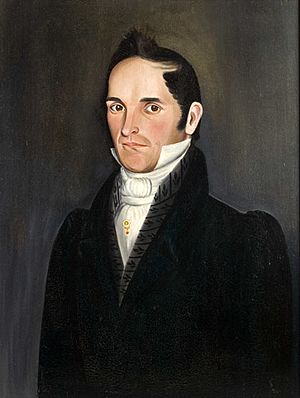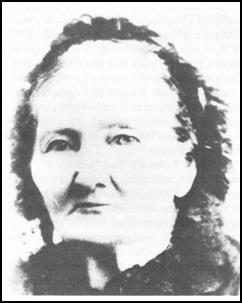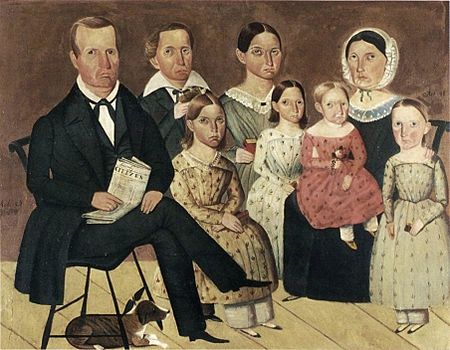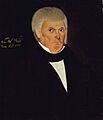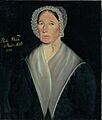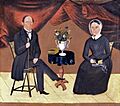Sheldon Peck facts for kids
Quick facts for kids
Sheldon Peck
|
|
|---|---|
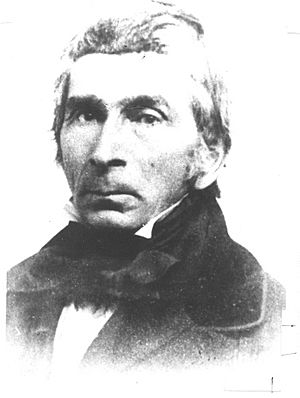 |
|
| Born | August 26, 1797 Cornwall, Vermont, United States
|
| Died | March 19, 1868 (aged 70) Babcock's Grove (present-day Lombard, Illinois), United States
|
| Occupation | Artist Farmer Social activist |
| Movement | Abolitionism Underground Railroad Racial equality Temperance movement Public education Women's rights Pacifism |
| Spouse(s) | Harriet Cory (m.1825–1869; his death) |
| Children | John Peck Charles Peck George Peck Abigal Peck Alanson Peck Watson Peck Martha Peck Henry Peck Susan Elizabeth Peck Abigal Corey Peck Sanford Peck Frank Hale Peck (Unnamed infant) |
| Parent(s) | Jacob Peck Elizabeth Gibbs |
Sheldon Peck (born August 26, 1797 – died March 19, 1868) was an American folk artist and a brave helper on the Underground Railroad. He was also a social activist who worked for many important causes. Peck's paintings have a special style. They are great examples of 19th-century American folk art. He was also known for supporting the end of slavery, racial equality, the temperance (avoiding alcohol), public education, women's rights, and pacifism (peace).
Contents
Early Life and Moving West
Sheldon Peck was born in Cornwall, Vermont. He was the ninth son of Jacob and Elizabeth Peck. His family helped start the New Haven Colony a long time ago. His father was a blacksmith and fought in the American Revolutionary War.
In 1825, Peck married Harriet Corey. They had thirteen children together. The Peck family moved to Jordan, New York in 1828. Then, in 1836, they moved even further west to Chicago. A year later, Peck settled in Babcock's Grove. This place is now called Lombard, Illinois. It is about 25 miles west of Chicago.
On his 160 acres of farmland, Peck built a large timber-frame house. It was finished in 1839 and is still standing today! He grew crops and raised Merino sheep. Raising sheep helped him get wool for clothes. This was important because it meant he didn't have to support the cotton industry in the South, which used enslaved African labor.
There are no records that Peck went to art school. His art might have been influenced by William Jennys. Jennys was a painter in Vermont when Peck lived there. Peck could also read art books from the Cornwall Young Gentleman's Society library.
Sheldon Peck's Artwork
Sheldon Peck mostly painted portraits of people. He also sometimes painted designs on furniture. Peck's portraits can be divided into three main periods. These periods are based on where he lived at the time.
Vermont Period (1820 - 1828)
Peck's first paintings were made around 1820. They were mostly oil portraits on wood panels. Many of his earliest paintings were of his own family. From the start, Peck used a simple style. In these early paintings, the people have serious faces. Their faces look a bit angular and don't show much emotion. The backgrounds are dark. By painting only the upper body, Peck avoided the challenge of painting full figures.
Peck's special design, the "rabbit track," started in this period. It looks like a rabbit's footprint. It's made of three brushstrokes: one long one with two shorter ones on the sides. You can often find this design in his paintings. It might be on clothing or in the background. This design was popular at the time. But it is so linked to Peck that it became his unofficial signature. He didn't usually sign his paintings, which was common back then.
New York Period (1828 - 1836)
When Peck moved to New York in 1828, he kept painting half-length portraits on wood panels. But he started using brighter colors. He also added more details to his subjects. These details included jewelry, Bibles, fruit, fancy furniture, and drapes in the background. These were popular ways to paint portraits at the time. This shows that Peck learned from other artists.
Illinois Period (1836 - 1869)
In 1836, Peck moved to Chicago. He lived there for only a few months. Then he moved to Babcock's Grove. Once in Illinois, Peck stopped using wood panels. He started painting on canvas instead. At first, he painted half-length portraits, similar to his earlier work.
But in Illinois, Peck's art changed a lot. Around 1845, daguerreotypes became popular. These were early photographs. To compete with photography, Peck started using even brighter colors. He also began painting multiple full figures in a horizontal way. This was similar to how photos were taken. Peck would also paint a fake frame directly onto the canvas. This was a "trompe-l'œil" effect, meaning it "tricked the eye." It probably helped lower the cost for his customers. They didn't have to buy a separate frame.
Sheldon Peck's Activism
From 1828 to 1836, Peck lived in an area of New York called the "burned-over district." This area was a center for many reform movements in the 1800s. These movements included ending slavery, temperance, women's rights, and public education. Peck believed in these ideas. He worked for social change throughout his life.
Fighting for Freedom: Abolitionism
Peck was known as a "radical abolitionist." This means he wanted slavery to end right away. He also believed that African Americans should have equal rights. When he lived in Illinois, he helped the abolitionist newspaper, the Western Citizen. He collected money for the newspaper and shared its anti-slavery ideas.
Peck was also a delegate for the Liberty Party. This political party's main goal was to end slavery. He was also part of the DuPage County Anti-Slavery Society. In 1856, Peck went to the Illinois State Abolitionism Convention. A newspaper called it a "Convention of Radical Abolitionists." This meant they talked about ending slavery and also about racial equality.
Peck often invited speakers to his home to talk about how wrong slavery was. Two important African-American speakers who visited were Johnny Jones and H. Ford Douglass. Johnny Jones was a free-born man who worked against slavery in Chicago. H. Ford Douglass was an escaped enslaved person. He was a great speaker and a friend of Frederick Douglass.
The Underground Railroad
Many stories confirm that Peck actively helped people on the Underground Railroad. The Underground Railroad was a secret network of safe houses and routes. It helped enslaved people escape to freedom. People believe Peck would hide "freedom seekers" on his property. Then, he would take them by wagon to Chicago. From there, the freedom seekers could travel to Canada by train or across the Great Lakes.
Another route was along the Fox Valley. Many people there hired Peck to paint their portraits. Freedom seekers could travel north on foot or by canoe along the Fox River to Wisconsin and then to Canada. Escaping to Canada became very important after the Fugitive Slave Act of 1850. This law meant that even if enslaved people reached free states in the North, they could still be returned to their enslavers. Peck traveled a lot for his painting work. This travel helped him hide his work with the Underground Railroad.
His youngest son, Frank Peck, wrote about his father's work in his journals. He often shared how their home was part of the Underground Railroad:
Back in my boy hood days, my father, who was an abolitionist, helped the Negroes escape from slavery in the South. Our home was used as a headquarters for all opponents of slavery in this part of the country, a station for the underground railway. I can remember one incident as clearly as if it was yesterday – when my father protected seven Negroes one night, when I was a small boy, helping them on their way to the Chicago district.
Frank Peck also remembered the spiritual songs he sang with the freedom seekers. He especially remembered songs sung by an Underground Railroad conductor named "Old Charley":
Roll on tibler moon, guide the tabler not astray
Whilest the nightingale song is in full tune
While I sadly complain to the moon.
"Tibler moon" in this song is thought to mean "traveling moon." This was a full, bright moon that helped escapees travel at night. Frank Peck's daughter also recalled that freedom seekers were "hid in barns around the [Peck] homestead." Then, they were "carried away the next day in a load of hay on their way to the Canadian border and freedom."
Promoting Temperance
The movements to end slavery and to promote temperance were often connected in the 1800s. Peck supported both causes. He held temperance meetings at his home. These meetings were often advertised in the Western Citizen newspaper. The Peck family also hosted "temperance picnics." These were fun, alcohol-free trips to Peck's farm for people from Chicago.
Like many people then, Peck believed that alcohol caused many social and health problems. His youngest son, Frank Peck, shared how important the idea of temperance was when he was growing up:
The temperance movement was much discussed...I am sorry to say that many of my friends and acquaintances have filled untimely graves from the effect of strong drink with deliriums and often troubles caused from it and I have helped care for some of them and have only one conclusion, it is a good thing to shun entirely.
Supporting Public Education
Before the 1820s, free public education was not seen as something the government should provide. But the reform movements of the 1800s changed this idea. Peck strongly supported free public education. He believed it was important to protect democracy and fight against a lack of knowledge.
When Peck arrived in Babcock's Grove in 1836, he started a school in his house. He paid the teacher, Amelda Powers Dodge, himself. He invited all the children in the area to come to classes. Later, he built another building on his property. This building was used as a school and a place for public meetings. Peck also served as a leader for a Sunday school at the local Methodist church.
Death and Legacy
Sheldon Peck died on March 19, 1868. His wife and ten of his thirteen children survived him. He is buried in the Lombard Cemetery. His youngest son, Frank, kept a diary. This diary is very helpful for historians. It tells about African American spiritual songs and the Underground Railroad.
The Sheldon Peck Homestead
Sheldon Peck's house from 1839 was given to the Lombard Historical Society by his granddaughter. It is now a museum called the Sheldon Peck Homestead. The museum teaches about Peck's work as an activist and artist. The house is listed on the National Underground Railroad Network to Freedom. This means it is a confirmed Underground Railroad site.
The Value of His Art
The value of Peck's art has grown a lot over the years. This shows how much folk and primitive art are now appreciated. His paintings can be seen in museums across the United States. These include the Art Institute of Chicago, the Chicago History Museum, and the American Folk Art Museum in New York City. Because Peck never signed his paintings, new "Peck portraits" are still being found!
Images for kids
See also


